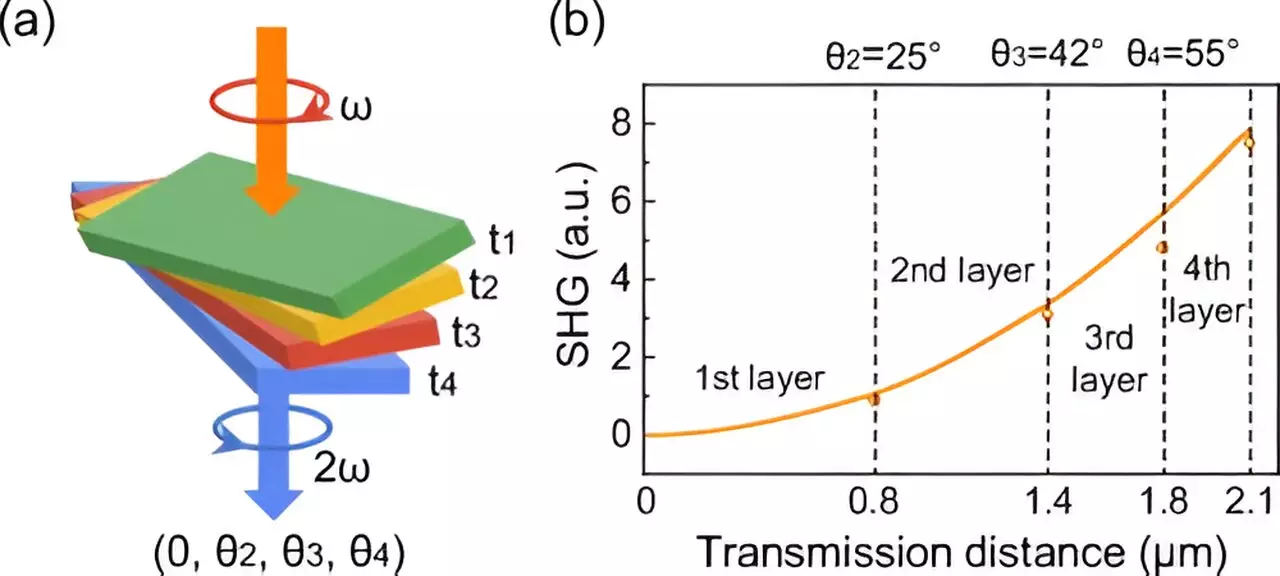A groundbreaking discovery by a team of Chinese researchers has paved the way for the next-generation of laser technology. Led by Professor Wang Enge from the School of Physics at Peking University, the team has invented a revolutionary ultrathin optical crystal called Twist Boron Nitride (TBN). With its micron-level thickness, TBN has skyrocketed the energy efficiency of optical crystals by 100 to 10,000 times. This remarkable achievement not only represents an original innovation in the theory of optical crystals but also opens up a new frontier in utilizing two-dimensional thin-film materials for light elements. Published in the prestigious journal Physical Review Letters, this breakthrough has the potential to transform laser technology as we know it.
Laser technology serves as one of the fundamental pillars of the information society. Optical crystals, in particular, play a critical role in various laser device functionalities such as frequency conversion, parametric amplification, and signal modulation. Over the past six decades, the development of optical crystals has largely relied on two phase-matching theories proposed by scientists in the United States. However, the existing crystals have faced significant challenges in meeting the evolving requirements for laser device development, including the need for miniaturization, high integration, and functionalization. The pursuit of new-generation laser technology necessitates breakthroughs in both optical crystal theory and materials.
Under the guidance of Professor Wang Enge and Professor Liu Kaihui, director of the Institute of Condensed Matter and Material Physics at Peking University, the team embarked on pioneering research to develop the twist-phase-matching theory. This theory, the third phase-matching theory based on the light-element material system, introduced a revolutionary concept into the realm of laser technology. Professor Liu aptly explained that the laser generated by optical crystals can be visualized as a marching column of individuals. The twist mechanism in TBN ensures optimal coordination of direction and pace among these individuals, resulting in a significant boost to the laser’s energy conversion efficiency. This groundbreaking research has not only revolutionized the design model and material system but has also showcased the team’s ability to seamlessly integrate basic optics theory with material science and technology.
One of the most notable features of the TBN crystal is its micron-level thickness. This ultrathin size is a vast departure from the traditional optical crystals, which typically exist at the millimeter or even centimeter scale. Such a significant reduction in size opens up a myriad of possibilities, from enhancing integration potential to unlocking new functionalities. The TBN crystal has the potential to achieve breakthroughs in various fields such as quantum light sources, photonic chips, and artificial intelligence. With the ongoing patent applications in the United States, Britain, Japan, and other countries, the TBN production technology is poised to make a substantial impact on laser technology worldwide.
Professor Wang emphasizes the crucial role of optical crystals in the future development of laser technology. The cornerstone of laser technology lies in the design theory and production technology of optical crystals, making breakthroughs in these areas essential for further advancements. With the advent of the TBN crystal and its unparalleled attributes, the prospects for laser technology are exceedingly promising. As researchers continue to explore the potential applications of the TBN crystal, the field of laser technology is on the cusp of an unprecedented revolution.
The invention of the Twist Boron Nitride (TBN) ultrathin optical crystal by a team of Chinese researchers marks a groundbreaking achievement in laser technology. Significantly improving the energy efficiency of optical crystals, TBN introduces a new era of utilizing two-dimensional thin-film materials for light elements. With its novel twist-phase-matching theory and patent applications worldwide, the TBN crystal has the potential to reshape various industries, from quantum light sources to photonic chips. Laser technology’s future lies in the hands of innovative design theories and advanced production technologies, and the TBN crystal is at the forefront of this revolution.


Leave a Reply